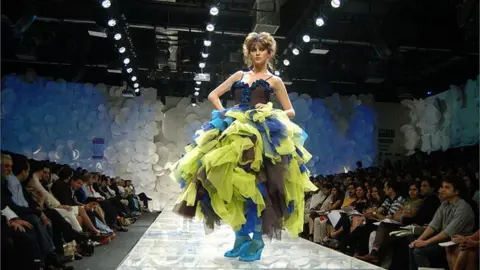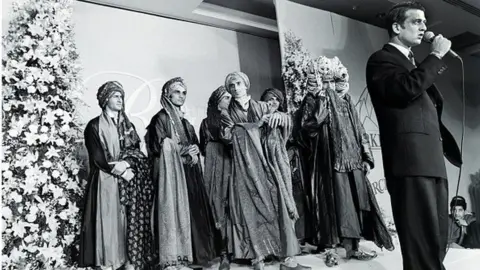ARTICLE AD BOX

 Getty Images
Getty Images
Bal's designs were marked by a deep understanding of Indian textiles
Rohit Bal, one of India's most celebrated fashion designers, has died aged 63 after a long period of illness.
The Fashion Design Council of India (FDCI) announced his death in a post on Instagram, saying that his work "redefined Indian fashion".
One of India's first designers, Bal popularised fashion designing as a viable, glamorous profession in the 1990s and many who came after him credit him for their success.
He had been forced to take a prolonged break due to ill health but made an emotional comeback just weeks ago.
"We will always need a Rohit Bal around to show what classic elegance is - and why it crosses the generational divide," said an article in The Indian Express newspaper after Bal, looking frail but delighted, appeared alongside his models at the grand finale of the India Fashion Week in October.
Bal's designs won acclaim for his deep understanding of Indian textiles and meticulous attention to detail.
His innovative creations were worn by Hollywood stars and supermodels and he became synonymous with blending India's rich cultural heritage with a contemporary flair.

 FDCI/Instagram
FDCI/Instagram
Bal (centre) had made an emotional comeback to the fashion scene just weeks ago
Born in Srinagar in Indian-administered Kashmir in 1961, Bal graduated from Delhi's St Stephens College with an honours degree in history. He then worked in his family's export business for a few years, learning the ropes.
After completing his formal education in fashion design at the National Institute of Fashion Technology (NIFT) in Delhi, Bal embarked on a journey that would redefine Indian fashion.
He set up his own label and designer line in 1990 and later opened several stores in India, the Middle East and Europe.

 Getty Images
Getty Images
A model displays a creation by Bal during a fashion show in Delhi
On his website, Bal described himself as a designer who "combines the right mix of history, folklore, village craft, and dying arts to create imaginative and innovative masterpieces for catwalks and fashion talks".
In 1996, Time magazine listed him as India's 'Master of fabric and fantasy'.
Bal's designs reached far and wide, with Hollywood actress Uma Thurman and supermodels Cindy Crawford, Naomi Campbell and Pamela Anderson wearing his creations. In 2001, tennis star Anna Kournikova walked the ramp for his Paris show.
Best known for his use of lotus and peacock motifs, Bal used rich fabrics like velvet and brocade - his designs were elaborate, inspired by Indian grandeur and royalty.
Apart from designing clothes in his own label, Bal lent his name to endorse products from shoes to linen, had tie-ups with textile giants like the Aditya Birla Group and even ventured into designing jewellery and luxury watches.
He also opened a line for children, saying that he believed that "children are a major consumer class in urban India".
Bal crafted costumes for the widely-watched Indian game show Kaun Banega Crorepati (Who Wants to be a Millionaire?) and designed costumes for the cabin crew of British Airways.

 Getty Images
Getty Images
Bal at a curtain call after a show in Delhi in 1996
He unveiled his inaugural prêt line for online retailer Jabong in 2014.
"I want to separate Rohit Bal from the House of Bal - in products as well as style, in expensiveness and expanse," Bal told Shefalee Vasudev in Mint newspaper.
"Rohit Bal stores (there will be no prêt here) will be special. People come to me only for special things - they want garments that are like handmade pieces of art. I have it in me to balance the right and left sides of my creative and business leanings."
When I met Bal years ago in his studio, his characteristic flamboyance was evident in dazzling neon coloured silks embellished with intricate embroidery; sleek blouses and skirts along with taffeta skirts and netted blouses, in bright, warm and cool colours.
"Fabric is the seed of designing a garment, it is the lifeblood of fashion," he told me.
His earliest memories of fabric were totally sensory, he said, recalling the downy feel of a jamawar shawl at home in Srinagar and the soft warmth of his mother's shahtoosh saris.

 Getty Images
Getty Images
Bal opened his own restaurant in Delhi
His early years in Srinagar contributed to what he described as a "blissful childhood". The idyllic life, he said, was disrupted by the violence in the region, compelling the family to relocate to Delhi.
Bal remembered embarking on a sartorial adventure at the age of 11 when he coaxed his father into a tailor's shop in Delhi to craft his own cowboy pants adorned with tassels.
Bal also diversified into the restaurant business and designed the interiors of one of Delhi's posh restaurants, Veda, whose opulent and extravagant interiors created a buzz in the Indian media.
He told me it was also okay with him if foreign brands like Armani or Hilfiger came to take up high street space in India.
"They can't do what I can with Indian designs," Bal said.
His flamboyant lifestyle prompted the Indian media to call him "the bad boy of fashion".
"People see me in photographs surrounded by pretty models and think that I am a snobbish, high-maintenance designer who is about beauty and hedonism. When they meet me, they realise how fake that perception is," he told Vasudev.

 2 months ago
10
2 months ago
10








 English (US) ·
English (US) ·